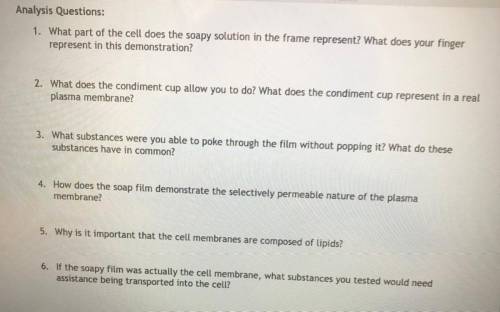
Biology, 29.01.2021 01:00, hardwick744
Mini Lab;
Materials: rectangular pan, dish soap, glycerin (com syrup), 2 straws, string (yarn), black paper, oil,
sugar, alcohol
1. Make your soapy solution by adding 50 ml of dish soap to your pan.
2. Then add two drops of glycerin (corn syrup) to the soap.
3. Cut a piece of string that's approximately four times the length of the straw. Thread it through the two straws and tie the ends together to make a loop.
4. Move the straws and string into the shape of a rectangle. This is your bubble frame. Cut the
excess string from the ends of the knot. Move the string through the straws so that the knot is
hidden inside one of the straws,
5. To create a handle for the frame, cut another piece of string that's approximately three times
the length of the straw. Thread the string through one of the straws and the ends together.
6. Dip your frame in the solution, hold the soap film in front of the black contruction paper Or other black material. Carefully observe the surface of the film. Blow ger on the film and
watch what happens.
7. Have a partner hold the frame that molds the cell membrane while you acts like materials
trying to get into the cell. Try poking your finger through the soap film. Record what happens.
If your film breaks in between trials immerse it in the soapy solution again.
8. Now wet your finger with water and poke it through the film. Then gently move it around the
frame in a circular motion. Record what happens.
9. Now dip your finger in the soapy solution and poke it through the film Racordul
10. Take the condiment cup with the bottom removed and grab it near one end. Now try to poke it through the film. Be sure to put the uncut end of the condiment Cup in first.
11. Now, immerse the condiment Cup in the soapy solution and poke it through the soapy solution. When u can successfully insert a bubble-solution-coated cup through the soapy film, leave the can in this position and have your partner pass u can object through the opening in the cup.
12.repeat with remaining substances


Answers: 1
Other questions on the subject: Biology

Biology, 21.06.2019 20:00, gracethegreat1
Surrounded by microtubules, located near the nucleus. (don't try to google it) (give answer only if u know)
Answers: 1

Biology, 22.06.2019 02:30, kajjumiaialome
4. rat liver is able to metabolize glucose by both the glycolytic and the pentose phosphate pathway. which of the following are properties of both the glycolytic and pentose phosphate pathway? a. nad+ is involved b. co2 is liberated c. phosphate esters are intermediates d. glyceraldehyde 3-phosphate is an intermediate e. fructose 6-phosphate is an intermediate4. rat liver is able to metabolize glucose by both the glycolytic and the pentose phosphate pathway. which of the following are properties of both the glycolytic and pentose phosphate pathway? a. nad+ is involved b. co2 is liberated c. phosphate esters are intermediates d. glyceraldehyde 3-phosphate is an intermediate e. fructose 6-phosphate is an intermediate
Answers: 3

Biology, 22.06.2019 10:30, isabellemaine
Differentiate renewable and nonrenewable resources
Answers: 1
Do you know the correct answer?
Mini Lab;
Materials: rectangular pan, dish soap, glycerin (com syrup), 2 straws, string (yarn), bla...
Questions in other subjects:

History, 14.10.2020 15:01



English, 14.10.2020 15:01

Social Studies, 14.10.2020 15:01

Mathematics, 14.10.2020 15:01

History, 14.10.2020 15:01

English, 14.10.2020 15:01

Social Studies, 14.10.2020 15:01






